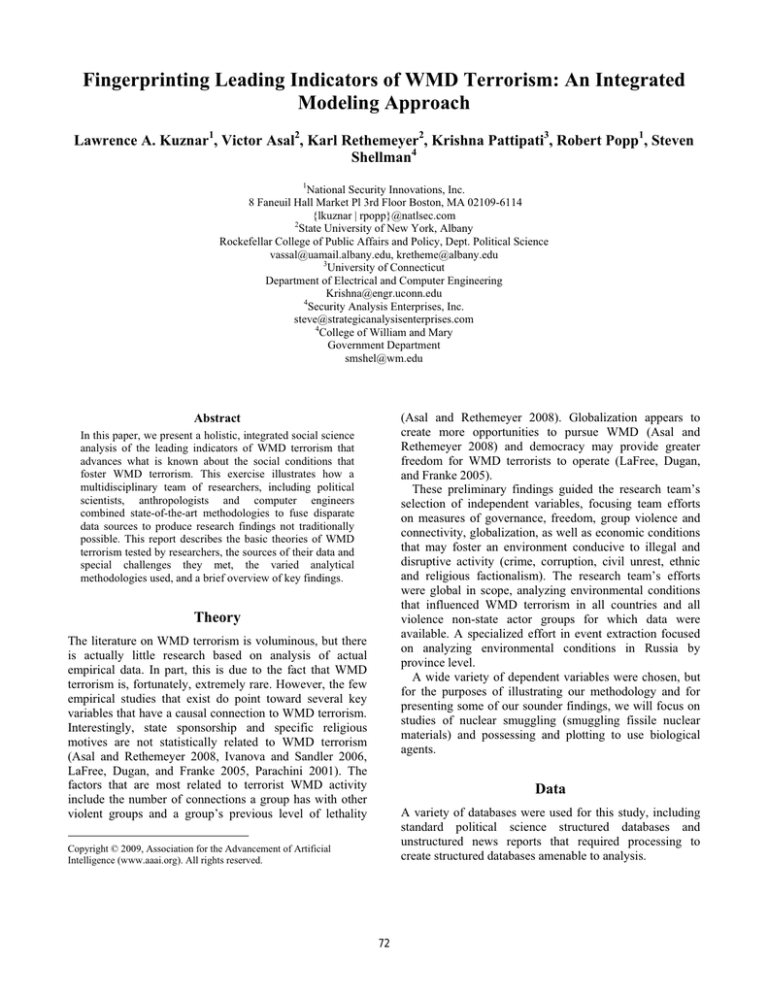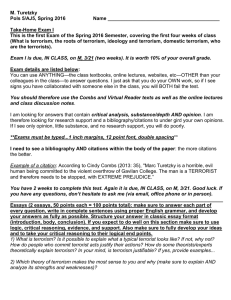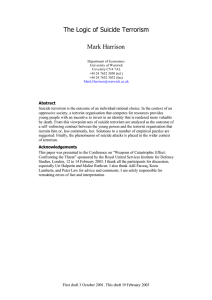
Fingerprinting Leading Indicators of WMD Terrorism: An Integrated
Modeling Approach
Lawrence A. Kuznar1, Victor Asal2, Karl Rethemeyer2, Krishna Pattipati3, Robert Popp1, Steven
Shellman4
1
National Security Innovations, Inc.
8 Faneuil Hall Market Pl 3rd Floor Boston, MA 02109-6114
{lkuznar | rpopp}@natlsec.com
2
State University of New York, Albany
Rockefellar College of Public Affairs and Policy, Dept. Political Science
vassal@uamail.albany.edu, kretheme@albany.edu
3
University of Connecticut
Department of Electrical and Computer Engineering
Krishna@engr.uconn.edu
4
Security Analysis Enterprises, Inc.
steve@strategicanalysisenterprises.com
4
College of William and Mary
Government Department
smshel@wm.edu
(Asal and Rethemeyer 2008). Globalization appears to
create more opportunities to pursue WMD (Asal and
Rethemeyer 2008) and democracy may provide greater
freedom for WMD terrorists to operate (LaFree, Dugan,
and Franke 2005).
These preliminary findings guided the research team’s
selection of independent variables, focusing team efforts
on measures of governance, freedom, group violence and
connectivity, globalization, as well as economic conditions
that may foster an environment conducive to illegal and
disruptive activity (crime, corruption, civil unrest, ethnic
and religious factionalism). The research team’s efforts
were global in scope, analyzing environmental conditions
that influenced WMD terrorism in all countries and all
violence non-state actor groups for which data were
available. A specialized effort in event extraction focused
on analyzing environmental conditions in Russia by
province level.
A wide variety of dependent variables were chosen, but
for the purposes of illustrating our methodology and for
presenting some of our sounder findings, we will focus on
studies of nuclear smuggling (smuggling fissile nuclear
materials) and possessing and plotting to use biological
agents.
Abstract
In this paper, we present a holistic, integrated social science
analysis of the leading indicators of WMD terrorism that
advances what is known about the social conditions that
foster WMD terrorism. This exercise illustrates how a
multidisciplinary team of researchers, including political
scientists, anthropologists and computer engineers
combined state-of-the-art methodologies to fuse disparate
data sources to produce research findings not traditionally
possible. This report describes the basic theories of WMD
terrorism tested by researchers, the sources of their data and
special challenges they met, the varied analytical
methodologies used, and a brief overview of key findings.
Theory
The literature on WMD terrorism is voluminous, but there
is actually little research based on analysis of actual
empirical data. In part, this is due to the fact that WMD
terrorism is, fortunately, extremely rare. However, the few
empirical studies that exist do point toward several key
variables that have a causal connection to WMD terrorism.
Interestingly, state sponsorship and specific religious
motives are not statistically related to WMD terrorism
(Asal and Rethemeyer 2008, Ivanova and Sandler 2006,
LaFree, Dugan, and Franke 2005, Parachini 2001). The
factors that are most related to terrorist WMD activity
include the number of connections a group has with other
violent groups and a group’s previous level of lethality
Data
A variety of databases were used for this study, including
standard political science structured databases and
unstructured news reports that required processing to
create structured databases amenable to analysis.
Copyright © 2009, Association for the Advancement of Artificial
Intelligence (www.aaai.org). All rights reserved.
72
missing values) as the dependent variable. This process is
repeated until all the missing values in the training data set
are filled. After the process for the training data is
completed, the same procedure is repeated on the
validation and testing patterns with missing values.
Structured databases
Structured databases focused on two units of analysis:
regions where WMD terrorism takes place, and terrorist
groups themselves. For regions, the characteristics of
countries were analyzed in order to identify environmental
conditions that were associated with WMD terrorism.
General data on countries, were gleaned from publicly
available data sets, which included International Atomic
Energy Agency data, Heritage US Troops stationed abroad
data, 2007 World Bank Development Indicators, DSTO,
CIA World Factbook, KOF Globalization Scores data,
1970-2007, and especially the Quality of Government
(QoG) dataset.
Sources of data on terrorist groups included the
Monterey WMD Terrorism Database, Monterey Institute
for
International
Studies
http://montrep.miis.edu/databases.html, and the Tactical
Terrorism Dataset, compiled by the Institute for the Study
of Violent Groups (ISVG) at Sam Huston State University.
Dr. Asal compiled these data into the Big, Allied and
Deadly (BAAD) terror group data set at SUNY Albany.
The researchers compiled data on 395 terrorist
organizations, and coded organizational variables for the
period 1998-2005 as one time period (no yearly data at
present).
Event Extraction from Unstructured Data
A specialized examination of nuclear smuggling in Russia
was conducted to evaluate the environmental conditions
that influenced nuclear smuggling by Russian province.
The data were obtained from Project Civil Strife using
automated methods to extract events of interest from text
reports. The source of the text came from 1 million BBC
monitor stories (i.e., 4.7 million lines/sentences of text)
from 1995-2005. BBC Monitor includes over 500 English
& foreign language sources. Dr. Shellman then added the
Moscow Times and the Moscow News as data sources.
To extract the text Shellman created actor and verb
dictionaries for the Russian case and regions and used Text
Analysis By Augmented Replacement Instructions
(TABARI) to extract the events of interest. From the texts
the researchers coded over 751,000 political events. Events
range from positive and negative statements to political
negotiations and armed conflict. Special events of interest
included nuclear smuggling activities. The repression,
protest, and cooperation variables are coded using the
CAMEO scheme (see the following web page for more
detail:
http://web.ku.edu/keds/data.dir/cameo.html).
Russian socioeconomic data were obtained from the Russia
& CIS Statistics Online Database compiled by Planet
Inform
(http://www.planetinform.com/Analytic/default.aspx).
Missing Data and the Imputation of Values
Nuclear smuggling and bio-terrorism data sources are
characterized by sparsity (estimating low probability
events ranging from 0.03 to 0.1 for nuclear smuggling data,
0.0027 to 0.013 for bio-terrorism data) and missing factor
data (typically, 3-79% of missing values).
We estimate missing data via support vector machine
regression (SVMR) and auto-regression. As a good data
pre-processing practice, we also normalize the factor data
so that it has zero mean and unit variance for each factor.
Scaling of data avoids undue influence of factors having
large values on conflict assessment. We also perform data
reduction via partial least squares (PLS) prior to
classification. Data reduction reduces noise in the data,
improves
classification/forecasting
accuracy
and
computational
efficiency,
and
reduces
memory
requirements (Choi et al. 2006).
If a few data points are missing for a factor, a three-step
auto-regressive model is used to fill the missing values.
This method is also used to forecast each factor. If a
country has missing values for all the years, SVMR is used
to fill the missing values. In this process, the given data is
divided into training, validation and test sets. Then,
complete patterns (with no missing values) from the
training set are selected. For each factor, we develop a
nonlinear regression model using support vector machine
regression (SVMR). After training SVM regression on
complete training patterns, missing values in the training
set are filled in sequentially by setting each factor (with
Methods
Information Gain Algorithm
Which factors have the most relevant information for each
NS and bio dependent variable? We address this question
via the Information Gain (IG) algorithm, informed by
social science experts. Information gain is related to the
concept of mutual information: how much information
does one random variable (a factor in our case) reveal
about another one (output or response variable in our
case)? To formalize this concept, we need to understand
the information-theoretic concept of entropy.
Entropy is a measure of how “disorganized” a set of data
related to random variable is; it is a measure of uncertainty.
Let y Y represent a dependent (response, output)
variable, where Y is a discrete random variable (binary or
multi-valued). Formally, entropy H(Y) is given by
H Y ¦ p y log 2 p y (1)
yY
Factors provide information on a dependent variable,
thereby reducing uncertainty in our knowledge of the
73
dependent variable. Letting x X denote a factor. Then,
entropy of Y after observing X is
H Y | X ¦ ¦ p x, y log 2 p y | x (2)
xX yY
The mutual information (information gain) is related to
H(Y) and H(Y|X) via
I XY
; HY
HY
| X HX
HX
|Y
HX
HY
HXY
,
ª p xy
, º
¦¦p xy, log «p x p y »
2
xXyY
¬
(3)
Figure 1: Fusion of HMM probability predictions and additional
input indicators using SVM
¼
Note that when X and Y are independent, p(x,y) =
p(x)p(y) (definition of independence), I(X;Y) = 0. This
makes sense: if they are independent random variables,
then X can tell us nothing about Y. Indeed, mutual
information is the relative entropy or Kullback-Leibler
distance between the joint distribution p(x,y) and the
product distribution p(x)p(y).
Mutual information provides a quantitative measure to
rank order factors in a decreasing order of mutual
information (information gain). If the costs of acquiring
data related to factors vary widely, one can rank order
factors in decreasing order of information gain per unit
cost of acquiring factor data. Formally, if c(X) denotes
the cost of acquiring factor X, information gain per unit
cost is I(X; Y) /c(X).
Support vector machines (SVM) transform the data to a
higher dimensional feature space, and find an optimal
hyperplane that maximizes the margin between the classes
(conflict levels in our case) via quadratic programming
(Bishop 2006, Choi et al. 2005). There are two distinct
advantages of using the SVM for classification. One is that
it is often associated with the physical meaning of data, so
that it is easy to interpret. The second advantage is that it
requires only a small amount of training data. A kernel
function, typically a radial basis function, is used for fitting
non-linear models by transforming the data into a higher
dimensional space (via “Kernels”) before finding the
optimal hyperplane to separate the classes. Data from 1998
to 2001 were used to train the model, and the model was
ten tested on data from 2002 to 2007.
A nice feature of our modeling process is that it extends
naturally to forecasting: The forecasting steps are as
follows:
1. Forecast Factors: If the factor is modeled as time series,
forecast it using an auto-regressive or nonlinear time series
forecasting methods (e.g., SVMR) models.
2. Forecast dependent variables
a. Compute predicted dependent variable probabilities
from the HMM dynamics.
b. Combine factor forecasts with the predicted dependent
variable probabilities.
3. Display dependent variable forecast.
Hidden Markov Modeling
HMMs provide a systematic way to make inferences about
the evolution of probabilistic events. The premise behind a
HMM is that the true underlying sequence (represented as
a series of Markov chain states) is not directly observable
(hidden), but it can be probabilistically inferred through
another set of stochastic processes (or sequences). In our
problem, the “hidden” sequence refers to the true
dependent variable sequence that describes the behavior of
a particular event over time. HMMs are perhaps a natural
choice for this problem, because we can evaluate the
probability of a sequence of events given a specific model,
determine the most likely state transition path, and estimate
parameters which produce the best representation of the
most likely path. An excellent tutorial on HMMs can be
found in Baum (1970).
Logistic Regression
In addition to SVM, HMM, IG forecasting analysis, more
traditional statistical analyses were performed on
structured databases. Logistic regression methods were
used since the dependent variables were discrete events,
and we were interested in predicting the probabilities of
these events.
Integration of HMM and IG for Forecasting
Figure 1 shows how country-specific HMMs for each
dependent variable are fused together with normalized
(observed or forecasted) factors to produce dependent
variable classifications/forecasts.
The predicted
probabilities from the dependent variable HMM model are
additional input factors to the statistical classifier, SVM.
Findings
Space does not permit an exhaustive presentation of the
research findings and their specific coefficients, goodness
of fit values, etc. However, a brief review of the project’s
major findings illustrate that this innovative teaming of
researchers, disciplines and methods clearly extended our
74
understanding of WMD terrorism. Findings were very
similar across all studies, regardless of scale (country or
Russian province), methodology or dependent variable.
The following factors were statistically related to
increases in the probability that nuclear smuggling or
bioterrorism will take place in a region.
References
Asal, V., and R. K. Rethemeyer. 2008. "Connections Can
Be Toxic: Terrorist Organizational Factors and the Pursuit
and Use of CBRN Terrorism." Manuscript, Rockefeller
College, University at Albany, State University of New
York. .
x
x
x
x
x
A strong black market
High unemployment
A globalized economy
A degree of industrial development
Sources of Chemical, Biological, Radiological, and
Nuclear (CBRN) material
x Ethnic/religious factionalism
Baum, L., T. Petrie, G. Soules, and N. Weiss. 1970. A
Maximization Technique Occurring in the Statistical
Analysis of Probabilistic Functions of Markov Chains.
Ann. of Math. Stat. 41:164-171.
Regions with a high likelihood of involvement in nuclear
smuggling or bioterrorism tend to be somewhat
Westernized and economically developed, but also have
high crime rates, worsening economies, and lack security.
The countries where these conditions occurred most
strongly included, Russia, Caucasus countries, Eastern
Europe, Central Asia, Turkey, India. Additionally, the
United States, Israel, Japan and the United Kingdom are at
risk of bioterrorism; the presence of religious cults in the
U.S., U.K. and Japan is a risk factor.
The attributes of terrorist groups that were statistically
related to their pursuit of nuclear smuggling or
bioterrorism included:
Bishop, C. M. 2006. Pattern Recognition and Machine
Learning. New York: Springer.
Choi, K., M. Azam, M. Namburu, J. Luo, K. R. Pattipati,
and A. Patterson-Hine. 2005. Fault Diagnostics in HVAC
Chillers
using
Data-driven
Techniques.
IEEE
Instrumentation and Measurement Magazine 8(3):24-32.
Choi, K., J. Luo, K. R. Pattipati, L. Qiao, and S. Chigusa.
2006. "Data reduction techniques for intelligent fault
diagnosis." Proc. Of the IEEE Auotestcon, Anaheim, CA,
2006.
x A history of highly lethal attacks
x A high level of connectedness to other VNSA groups
x Experience with violent terrorist activities
Ivanova, K., and T. Sandler. 2006. CBRN Incidents:
Political Regimes, Perpetrators, and Targets. Terrorism
and Political Violence 18:423-448.
Additionally, religious cults are strongly associated with
bioterrorism.
Specific groups predicted on the basis of historical data
to be involved with nuclear smuggling and/or bioterrorism
include:
Lafree, G., L. Dugan, and D. Franke. 2005. The Interplay
between Terrorism, Nonstate Actors, and Weapons of
Mass Destruction: An Exploration of the Pinkerton
Database. International Studies Review 7:155-158.
x
x
x
x
x
x
x
x
x
x
x
x
x
Al-Qaeda
Abu Sayyaf Group (ASG)
Jemaah Islamiya (JI)
Riyad us-Saliheyn Martyrs' Brigade (Chechen Militants)
Hamas
Jamatul Mujahedin Bangladesh
Revolutionary Armed Forces of Colombia (FARC)
Self-Defense Forces of Colombia (AUC)
National Liberation Army (Colombia) (ELN)
Irish Republican Army (IRA)
PKK
Armed Islamic Group
Al Aqsa Martyrs Brigade
Parachini, J. V. 2001. Comparing Motives and Outcomes
of Mass Casualty Terrorism Involving Conventional and
Unconventional Weapons. Studies in Conflict and
Terrorism 24:389-406.
Distribution A: Approved for public release; distribution is
unlimited (88ABW-2008-0660). The information and
opinions stated represent the views of the authors and not
the United States Government or Department of Defense.
75






